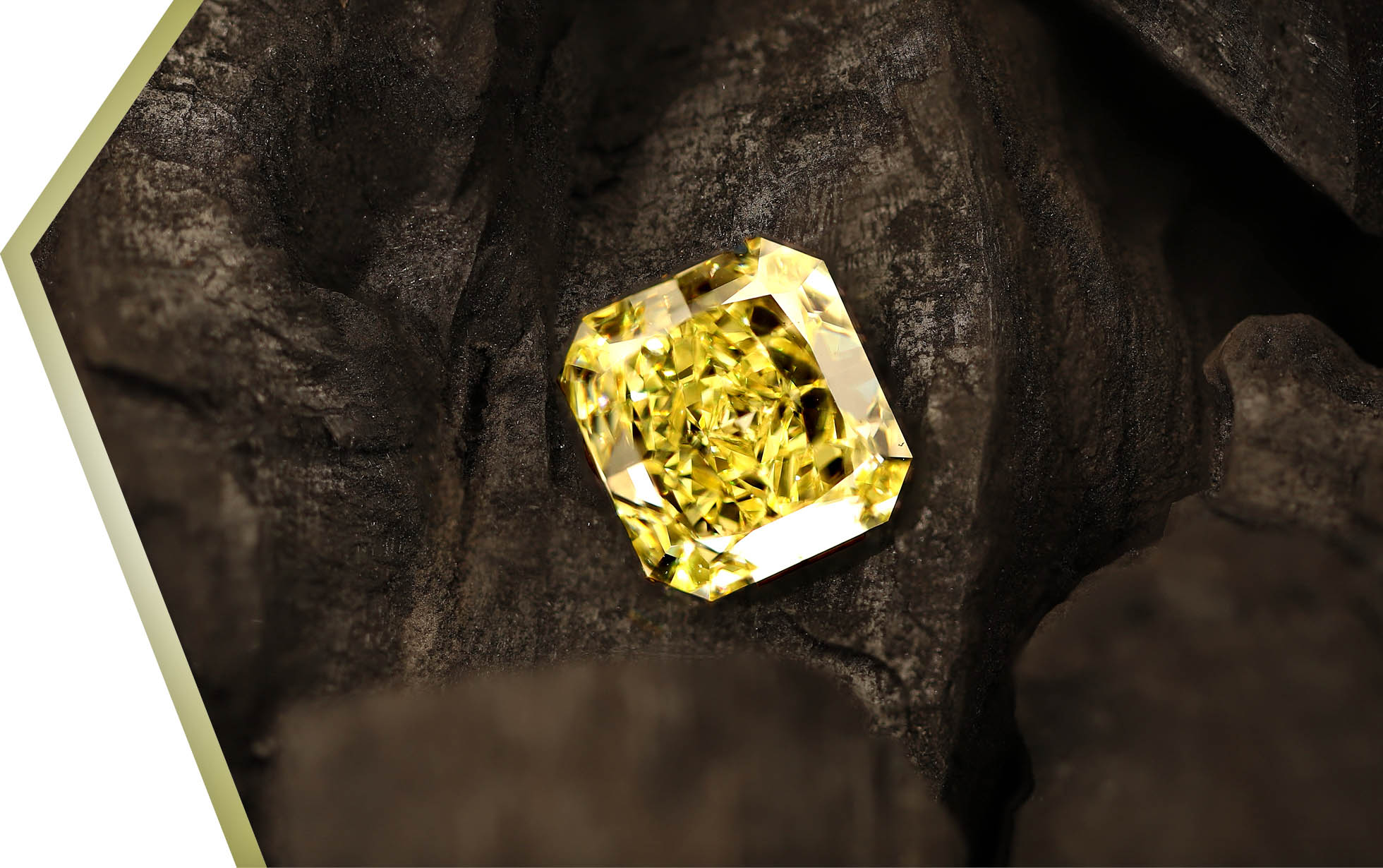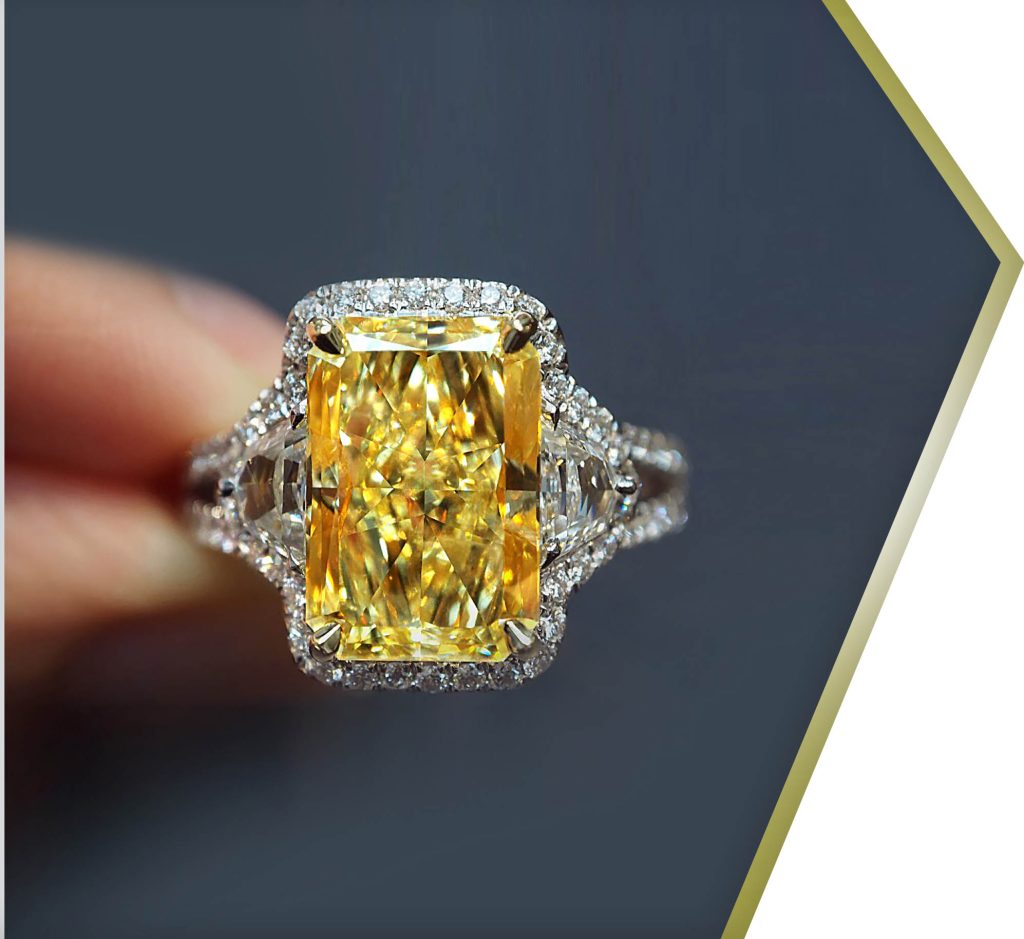Fancy yellow diamonds
Fancy Yellow diamonds, also known as Canary diamonds, are one of the most sought-after colored diamonds in the world. These diamonds are prized for their intense and vivid yellow color, which can range from light lemon yellow to deep amber. In this article, we will discuss the origin of the color, color spectrum and range, how to value them, how they are created in nature and some history about Fancy Color Diamonds.
The color in Fancy Yellow diamonds is caused by the presence of nitrogen molecules within the crystal structure. These nitrogen molecules absorb blue light, which causes the diamond to appear yellow. The amount and type of nitrogen present in the diamond determine the intensity


and shade of the yellow color.Fancy Yellow diamonds can range from pale yellow to intense and vivid yellow. The Gemological Institute of America (GIA) grades the color of Fancy Yellow diamonds on a scale from Light to Fancy Vivid, with Fancy Vivid being the most valuable and sought after. The color of Fancy Yellow diamonds can also be influenced by other factors such as fluorescence, which can make the diamond appear whiter or cloudier.
The value of a Fancy Yellow diamond is determined by several factors such as color intensity, size, clarity, and cut. The most important factor, however, is the intensity and saturation of the yellow color. The more intense and vivid the yellow color, the more valuable the diamond is. The most famous source of Fancy Yellow diamonds is the Zimmi diamond mine in Sierra Leone. This mine produces some of the most exceptional and rare Fancy Yellow diamonds in the world. The Zimmi diamond mine is known for producing diamonds with a rich, saturated yellow color and a high level of transparency.
Fancy Yellow diamonds are formed deep within the earth’s mantle under extreme pressure and high temperatures. The nitrogen molecules that give Fancy Yellow diamonds their yellow color are believed to be introduced into the diamond crystal during its formation process. This process can take millions of years, and only a small percentage of diamonds are colored, making them a rare and valuable find.
Fancy Color Diamonds have been treasured for centuries and were once reserved for royalty and the wealthy elite. The first recorded discovery of a Fancy Color Diamond was in India in the 17th century. Since then, Fancy Color Diamonds have been found in various parts of the world, including South Africa, Australia, and Brazil. In recent years, Fancy Color Diamonds have gained popularity and have become increasingly sought-after by collectors and investors. Their rarity, beauty, and uniqueness make them a valuable addition to any collection.
In conclusion, Fancy Yellow diamonds are a highly prized and rare type of colored diamond. Their intense and vivid yellow color is caused by the presence of nitrogen molecules within the crystal structure. The Zimmi diamond mine in Sierra Leone is the most famous source of Fancy Yellow diamonds in the world. The value of a Fancy Yellow diamond is determined by several factors, including color intensity, size, clarity, and cut. Despite their long history, Fancy Color Diamonds remain highly sought after and continue to captivate collectors and investors with their beauty and rarity.
Unlock the Secrets of Diamonds!
Join our Weekly Newsletter Today!

How to Buy Diamonds – Part 2: Colored Diamonds
How to Buy Diamonds – Part 2: Colored Diamonds Colored diamonds – a vast spectrum of beauty and options When it comes to purchasing diamonds,

How to Buy Diamonds: Key Factors Every Buyer Should Know
How to Buy Diamonds: Key Factors Every Buyer Should Know The Diamond Connoisseur’s Handbook: What Every Buyer Must Understand. If you’re considering how to buy

Yellow Diamonds – What causes diamonds to appear yellow?
Yellow Diamonds – What causes diamonds to appear yellow? In the world of fancy-color diamonds, those with vibrant blue, green, and red hues reign supreme

Fancy green diamonds
Fancy green diamonds Fancy Green Diamonds: A Rare and Exquisite Gemstone Diamonds are often associated with colorless stones that sparkle with brilliant fire, but they

Fancy blue diamonds
Fancy blue diamonds Blue diamonds are some of the rarest and most sought-after gems in the world. Known for their mesmerizing and intense blue hue,

Fancy pink diamonds
Fancy pink diamonds Pink diamonds are one of the rarest and most sought-after gemstones in the world. These dazzling gemstones are known for their unique
